50/50 Custody Not Working... when co-parenting has negative effects on kids
50/50 custody doesn't work in some situations, such as for infants and toddlers, where parents live far apart or if one has an addiction problem. Equal co-parenting then becomes inappropriate and has negative effects. Here are the main arguments against joint physical custody.

Andrew Lancaster
Timtab Founder
April 4, 2020
Share article:
The case against 50/50 custody has been made many times. Some of the claimed disadvantages are true while others have been disproven. Our list of the main arguments against equal joint custody is divided into two categories: "actual" and "myths".
Definitions
50/50 custody means a child spends equal amounts of time in the care of each parent. Joint physical custody is where each co-parent has at least 35% care time.
50/50 custody is a form of joint physical custody, along with similar arrangements such as 60/40.
Actual Disadvantages of 50/50 Custody
50/50 custody doesn't work when it's used in the wrong situation. While the benefits of joint custody are many, significant disadvantages also exist. Here are the main cons of joint custody.
1. Exact 50/50 custody is disruptive for very young children
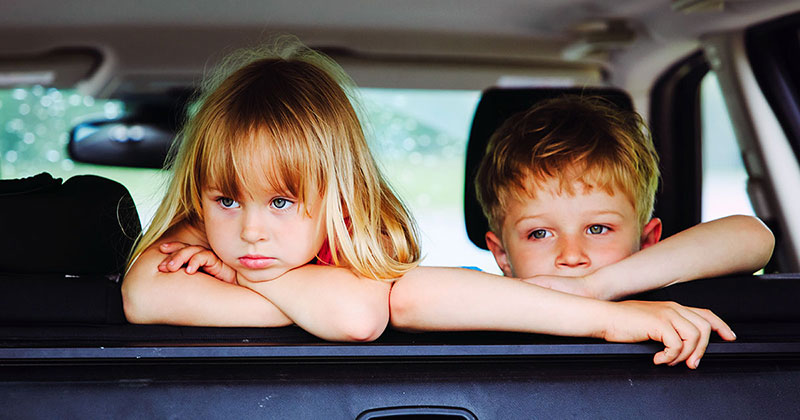
For very young children, exact 50/50 custody makes for a disrupted life. Have a look at the top-rated 50/50 custody schedule for a baby for example. It requires 12 trips between homes per fortnight. And, still, the baby must spend 2 nights in a row away from each parent at different stages.
Top rated 50/50 custody schedule for a baby

The schedule is far from ideal. If equal time was not required, Timtab AI software would choose a schedule where the baby visits the non-custodial parent either (a) three times per week without staying overnight or (b) twice a week with an overnight stay each time.
Babies and toddlers are ill-suited to equal co-parenting because a night or two away from a caregiver feels like a long time to them. A schedule with a primary caregiver (usually the mother) is the safer alternative approach.
The consensus seems to be that a gradual “step-up” plan is best. Frequent overnights in young children causes insecurity.
Keith Pickard
Interestingly, a 60/40 custody schedule is highly rated for a child aged 1 to 3. And 50/50 schedules are popular for school-aged children. Equal co-parenting becomes more workable as children mature and are less affected by time away from a primary carer.
Top-rated schedule for a toddler: any type
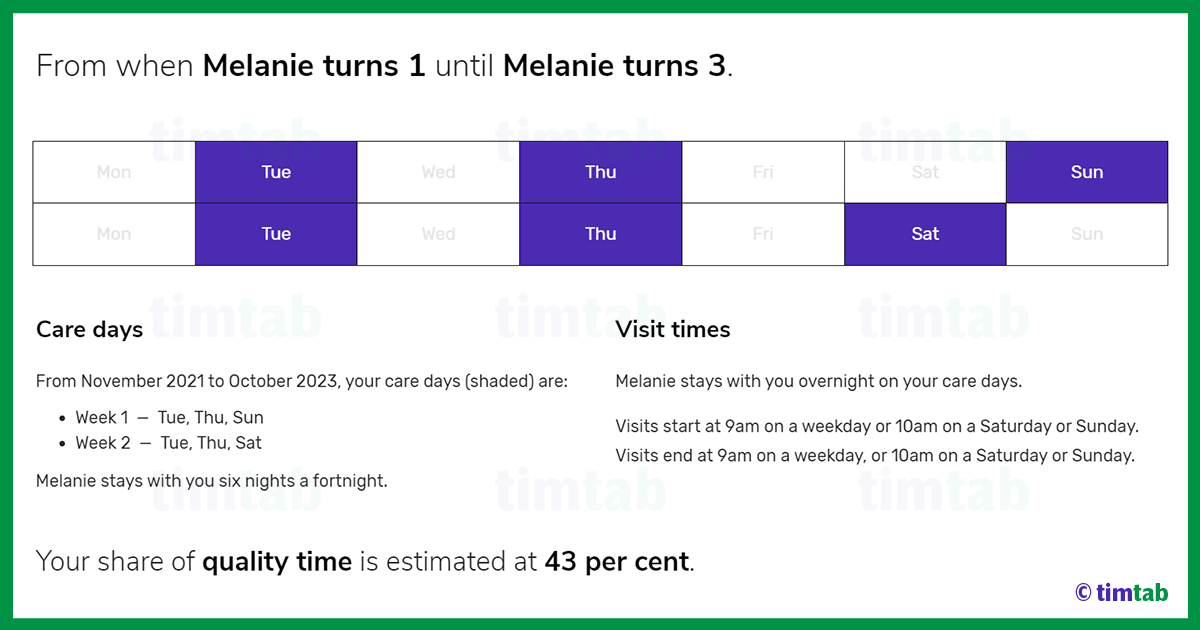
We can say that, while joint physical custody may be a good option for young children, exact 50/50 schedules are too disruptive. A baby in particular needs a consistent carer during this early stage of life.
See also: Best Custody Arrangements for Toddlers... parenting plans for kids aged under 4
2. Co-parenting doesn't work when travel times are long
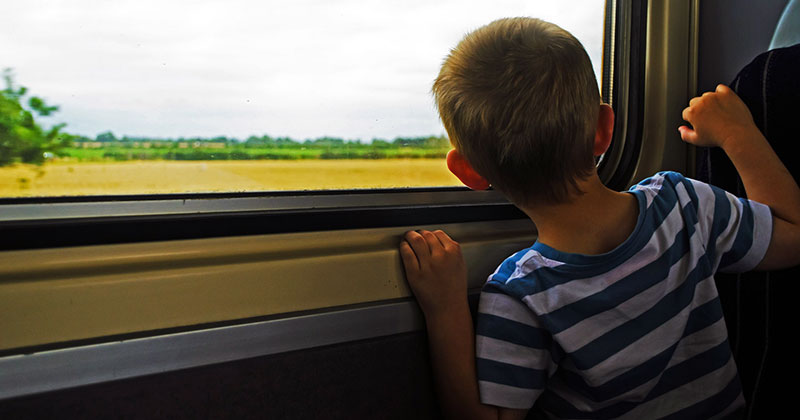
Maintaining 50/50 custody becomes harder the farther parents live from one another. An equal split actually makes little sense if one parent is more than about 15 minutes from a child's school than the other. You end up making children do extra commuting for little gain.
You can see the drawback of equal custody from the "non 50/50" schedule below. It's the top-rated schedule for a child aged 8+ where one parent lives 15 minutes further from school than the other (e.g. 25 minutes school commute vs 10 minutes).
Top-rated schedule with 15 minutes difference in commute times
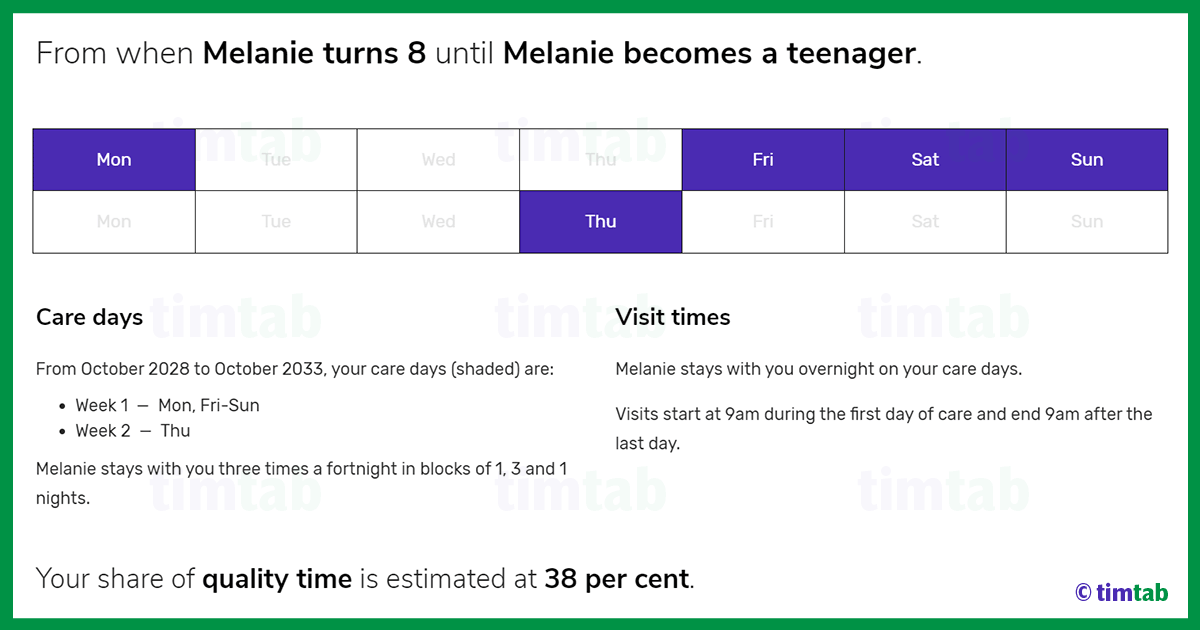
The best plan in this situation has 65/35 custody, not 50/50. Note that the split is a more equitable 62/38 when measured in terms of "quality time" -- after excluding activities such as sleeping and working.
- In effect, one parent gives up two midweek nights of custody each fortnight. That saves an hour of commuting for the child and possibly for the parent as well.
- Sole custody becomes appropriate when commute times are longer. As the travel difference starts to extend to an hour or more per trip, visits with the distant parent need to be restricted to weekends and school breaks.
This problem of travel and co-parenting is not about doing extra trips between homes. All regular changeovers can happen naturally via school.
The negative effect of joint custody is to increase travel times. Joint physical custody prevents a child from taking advantage of one parent's closer proximity to school -- a place the child needs to get to or from ten times a week.
3. Joint custody is inappropriate for an unfit parent

No parent should have joint custody of a child if they are genuinely unfit to be a parent. The problems of the father or mother -- whether it relates to drug addiction, alcohol abuse, mental illness, abusive behavior, prostitution, neglect, etc -- can have numerous negative effects on the child or children.
You want time with an unfit parent to be none, or minimal and supervised. That cannot be achieved with joint physical custody, which is often defined as a child being under each parent's care at least 35% of the time.
Under Nevada law, for example, parental rights may be terminated if a parent is deemed "unfit". An unfit parent is defined as "any parent of a child who, by reason of the parent’s fault or habit or conduct toward the child or other persons, fails to provide such child with proper care, guidance and support." (Nevada Revised Statutes)
We should distinguish here between an unfit parent and a parent who is "not great" in the opinion of the other parent or someone else. Joint custody doesn't have to be abandoned just because a parent is an average cook or messy around the home for example.
4. Parents can screw up joint custody, causing problems for children

Some of the negative effects of 50/50 custody that you read about are really the result of mismanagement. The identified problems for children could be prevented if parents did things differently.
Mistakes in handling joint custody appear to come from a lack of knowledge as much as anything. Shared parenting is not inherently difficult. Parents need to problem solve if they find 50/50 custody not working.
For example, there is a widespread misconception that co-parents should be in constant communication. This is completely untrue. Successful co-parenting is often achieved by parallel parenting, where communication is kept to a minimum. Joint custody can be just fine where each parent focuses on taking care of their own business.
To avoid problems, here are some of the strategies to use.
- See what custody schedule Timtab creates for you. A good custody schedule has kids swapping homes at the perfect time to see the other parent again.
- Be consistently warm and friendly with your child every time he or she arrives. Children look forward to changeovers when they feel welcome and loved.
- Give your place a home feel. That includes giving your child their own things and spaces and not re-arranging their stuff when they're away. Also, try to involve them in the running of the place, including chores and input into buying furniture, games, etc.
- Buy your kids everything they need. They should usually be able to go between homes with just a small backpack. Only have them transport items like sports shoes and homework.
- Have a good catch-up session with your kids whenever they visit. That's essential for continuity in your relationship. You can be a full-time parent even if you only see your kids half the time.
50/50 Custody Disadvantage Myths
Joint custody is often opposed using reasons that are weak, inaccurate or overblown. Let's look at these mythical disadvantages of 50/50 custody, along with relevant evidence.
I should say that some of the analysis may look pro-father. Such an appearance is inevitable. False arguments about shared parenting mainly act to prevent fathers from having reasonable time with their children. Mothers who want joint custody are more likely to face a different problem: the father refusing to do his fair share.
Myth 1: Joint custody hurts kids with "high conflict" parents

A widespread but slowly dying myth says that children with high-conflict parents are better off in sole rather than joint custody. The idea behind this view is that, by reducing interactions between parents, you prevent children getting caught up in damaging inter-parental conflict. "High conflict" parents struggle to resolve problems by themselves, battle over custody and may have hostility issues.
A serious flaw with the theory is that the ultimate cure -- removing one parent -- creates all sorts of problems in itself. Children who never see one parent do worse on many measures of well-being. Furthermore, it is unclear to what extent, if any, downgrading a parent to occasional visits prevents conflict.
Research in this area is coming down on the side of joint physical custody being beneficial irrespective of whether parents can be considered "high conflict". An examination of 19 studies found that, independent of parental conflict, joint physical custody is "generally linked to better outcomes for children" (Linda Nielsen).
Shared parenting can ameliorate the harmful effects of high conflict: a warm relationship with both parents is a protective factor for children.
Edward Kruk
Technology is also reducing conflict and negative effects on children. With digital communication, co-parents don't have to talk to one another. Joint custody can be managed with text messages and emails. Timtab offers a free communication plan for any parent who wants to avoid conflict with their ex.
Myth 2: Moving between homes makes kids confused, anxious and tired

Another criticism of joint custody is that regularly moving between homes has negative effects on children (and not just babies or toddlers). The concern is that children may be confused, tired and even anxious from all the activity and change. Analogies such as "bounced around like a yo-yo" and kids being treated like "ping pong balls" are commonly used.
The argument is not supported by evidence. Children themselves don't report it as an issue. And the alternative, which is long absences from at least one parent, has been shown to be detrimental.
If the "bounce effect" was really a problem, how can we let children go to school (or daycare)? The back and forth from attending school is much more demanding. Trips to and from school happen twice daily. Classrooms and playgrounds are also more challenging environments than a home.
A good parenting plan limits the number of changeovers and schedules them to happen via school. No extra travel is actually needed. If a child can handle attending school, in a way they have already proven themselves more than able to cope with living across two homes.
Myth 3: Kids should live with the better parent, usually their mother
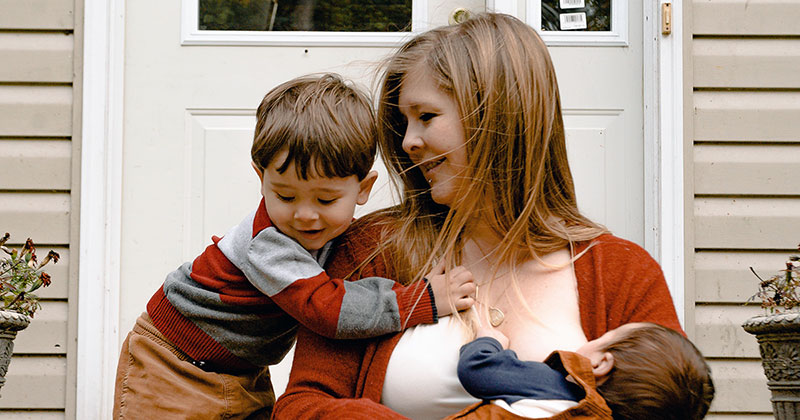
There is a pervasive view that children should live with their mother and just visit their father; that such an arrangement is fine and often best for kids. While shared or joint custody is on the rise, still the most common outcome is that children end up in the primary care of the mother.
- In Canada, less than 10% of custody orders have the father with the primary residence. The mother was the primary carer in 52% of cases in 2012-2015. Source: Department of Justice
- In Wisconsin, the share of cases where the mother was awarded sole custody fell from 80% in 1986 to 42% in 2008. Equal and shared custody accounted for 27% and 18% of case outcomes respectively in 2008. Source: Cancian et al
- In Australia, mothers are awarded majority care by judges 46% of the time. Shared care is applied in 21% of contested cases while 3% of fathers are given majority care. Source: Australian Institute of Family Studies
The idea that children do well in the primary care of their mother is not supported by statistics for single-mother households. Children raised without their biological father do poorly on many measures of well-being. This at least indicates that mothers often need help; that one parent cannot satisfactorily do the job of two.
And we also see benefits from joint physical custody where fathers are more than bit players. Linda Nielsen found that children do better on a general wellness index -- covering emotional and physical health, academics and more -- where fathers have at least 35% custody.
Myth 4: As long as kids see their fathers sometimes, joint custody isn't worth the trouble

Alongside the myth that children do just fine with their mother as the custodial parent is a view that children don't need to spend much time with their father. With father-child time not mattering much, shared custody is considered to not be worth the logistical hassles. For example, Robert Emery has stated "I consider about 25 percent of overnights as being joint physical custody in terms of having enough opportunity to have a rich relationship with your children."
Converted into a custody schedule, 25% care amounts to every second weekend plus half-time during school breaks. In turn, that means children would go without seeing their father for 11 consecutive days most fortnights.
Perhaps there's a reason why 35%, and not 25%, is the usual threshold for defining joint custody. Really, how can you be a proper father to your children when you're only with them a quarter of the time?
If anything unexpected happens in a child's life, a non-custodial parent probably won't be around to help. Children in sole custody have to continually rely on themselves or the custodial parent for guidance and support.
A recent study found that "somewhere between 33% and 40% time with the father" is about where extra time with a father starts to matter less. Below this range, more parenting time seems to clearly improve the quality of the father-child relationship.
Myth 5: Moving to 50/50 custody involves risky changes

Moves towards 50/50 custody are commonly opposed on the grounds that a child has an established living arrangement that is working. Changing the arrangement is seen as potentially unsettling, a possible cause of anxiety and, ultimately, unnecessary.
We see this kind of thinking in the use of the primary caregiver concept and with attachment theory. In contested custody hearings, judges take into consideration which parent has been doing most of daily parenting chores and which parent a child is most bonded to.
But we know that moving to shared physical custody is actually low risk. Children are adaptable and joint custody offers many benefits. Sole custody, on the other hand, is associated with numerous negative outcomes for children, such as poorer psychosomatic health.
- A bond with a second parent can normally be formed or strengthened quickly.
- Just because a parent hasn't spent much time on certain child-rearing tasks before doesn't mean they're incapable of doing them. Almost anyone can perform routine parenting chores such as organizing meals or getting kids to school.
In cases where parents were living together recently, it also seems to be forgotten that both parents were spending 100% of nights (or close to it) with the child or children. Moving to sole custody should therefore be seen as the radical, risky option.
Myth 6: Joint custody places a parent's rights above the best interests of a child
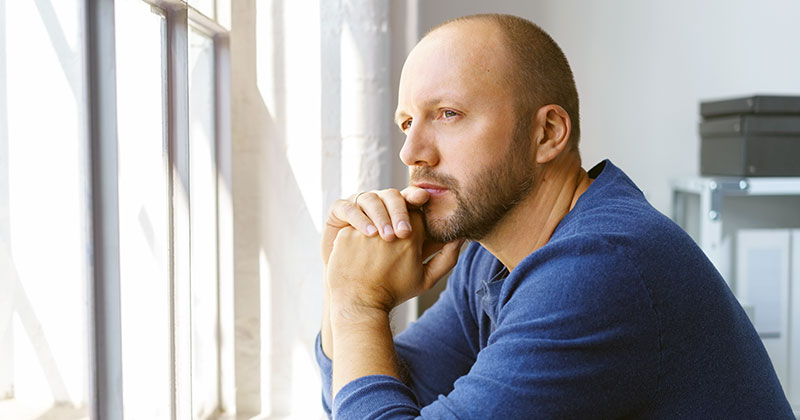
Shared parenting is at times viewed as clashing with the principle that decisions should be made in the best interests of the child. A judge who gives parents equal time could be seen to be prioritizing fairness towards parents above other considerations. Many countries and states have been reluctant to make joint custody the presumptive position in custody cases.
To further complicate things, custody battles can often be characterized as the mother wanting sole / primary custody and the father wanting joint custody. Fathers would be consistently "winning" in court if shared parenting was the stock-standard arrangement.
But the fact is that children generally do better when custody is shared. And, for parents who were raising a child together, 50/50 is the natural starting position for a parenting agreement. If the "politics" were entirely removed, joint custody would still be the obvious default arrangement.
Myth 7: Fathers are too dangerous to have joint custody
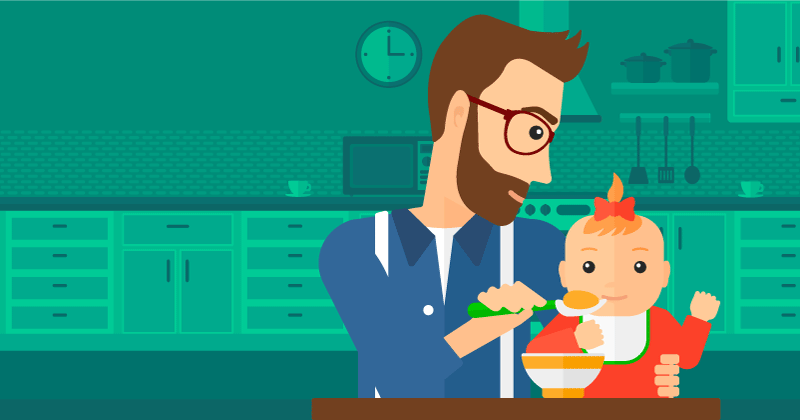
Fathers are routinely denied joint custody by courts, especially in interim orders, where allegations of conflict or domestic violence are made. Often this is done just as a precaution, without the allegations having been tested. But the effect is still the same: a child is denied normal access to their father because he is perceived as dangerous.
A Judge will err on the side of caution by giving the father very limited time with the children in the interim, often subject to strict conditions such as supervision.
TGB Lawyers
Caution towards fathers is usually misplaced however. Biological fathers do not pose special risks to their children. For example, decade-long statistics for Australia show that children are more likely to be murdered by their mother or her new boyfriend / partner than by their biological father (Australian Institute of Criminology).
Limiting father-child time is also ineffective at preventing domestic violence. While contact frequency goes down, tension and hostility between parents tend to rise. No advantage in terms of violence prevention has been demonstrated for sole custody above joint custody.
There is simply no evidence for a linear relationship between the time that non-resident parents spend with their children, and a greater incidence of post-separation violence towards the primary caregiver.
Patrick Parkinson
Violence and abuse are problems that need addressing, whether the potential perpetrator is a father, mother or another person. But, to put it simply, shared parenting does not cause domestic violence and primary custody is not the solution.